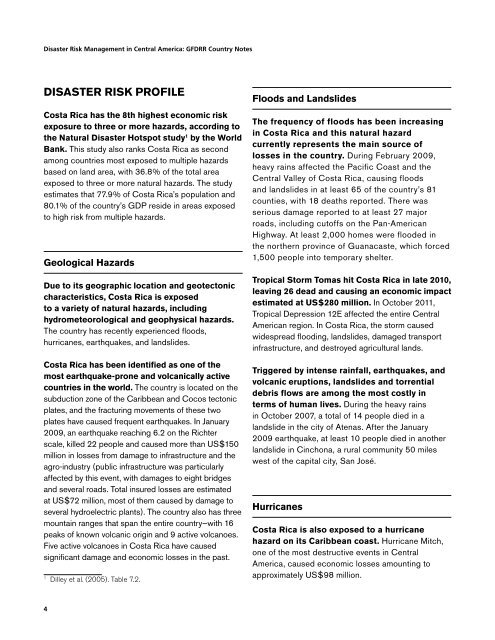Disaster Risk Management in Central America: GFDRR Country Notes
Disaster Risk Management in Central America: GFDRR Country Notes
Disaster Risk Management in Central America: GFDRR Country Notes
Create successful ePaper yourself
Turn your PDF publications into a flip-book with our unique Google optimized e-Paper software.
<strong>Disaster</strong> <strong>Risk</strong> <strong>Management</strong> <strong>in</strong> <strong>Central</strong> <strong>America</strong>: <strong>GFDRR</strong> <strong>Country</strong> <strong>Notes</strong><br />
disaster risk profile<br />
Costa Rica has the 8th highest economic risk<br />
exposure to three or more hazards, accord<strong>in</strong>g to<br />
the Natural <strong>Disaster</strong> Hotspot study 1 by the World<br />
Bank. This study also ranks Costa Rica as second<br />
among countries most exposed to multiple hazards<br />
based on land area, with 36.8% of the total area<br />
exposed to three or more natural hazards. The study<br />
estimates that 77.9% of Costa Rica’s population and<br />
80.1% of the country’s GDP reside <strong>in</strong> areas exposed<br />
to high risk from multiple hazards.<br />
Geological Hazards<br />
Due to its geographic location and geotectonic<br />
characteristics, Costa Rica is exposed<br />
to a variety of natural hazards, <strong>in</strong>clud<strong>in</strong>g<br />
hydrometeorological and geophysical hazards.<br />
The country has recently experienced floods,<br />
hurricanes, earthquakes, and landslides.<br />
Costa Rica has been identified as one of the<br />
most earthquake-prone and volcanically active<br />
countries <strong>in</strong> the world. The country is located on the<br />
subduction zone of the Caribbean and Cocos tectonic<br />
plates, and the fractur<strong>in</strong>g movements of these two<br />
plates have caused frequent earthquakes. In January<br />
2009, an earthquake reach<strong>in</strong>g 6.2 on the Richter<br />
scale, killed 22 people and caused more than US$150<br />
million <strong>in</strong> losses from damage to <strong>in</strong>frastructure and the<br />
agro-<strong>in</strong>dustry (public <strong>in</strong>frastructure was particularly<br />
affected by this event, with damages to eight bridges<br />
and several roads. Total <strong>in</strong>sured losses are estimated<br />
at US$72 million, most of them caused by damage to<br />
several hydroelectric plants). The country also has three<br />
mounta<strong>in</strong> ranges that span the entire country—with 16<br />
peaks of known volcanic orig<strong>in</strong> and 9 active volcanoes.<br />
Five active volcanoes <strong>in</strong> Costa Rica have caused<br />
significant damage and economic losses <strong>in</strong> the past.<br />
1<br />
Dilley et al. (2005). Table 7.2.<br />
Floods and Landslides<br />
The frequency of floods has been <strong>in</strong>creas<strong>in</strong>g<br />
<strong>in</strong> Costa Rica and this natural hazard<br />
currently represents the ma<strong>in</strong> source of<br />
losses <strong>in</strong> the country. Dur<strong>in</strong>g February 2009,<br />
heavy ra<strong>in</strong>s affected the Pacific Coast and the<br />
<strong>Central</strong> Valley of Costa Rica, caus<strong>in</strong>g floods<br />
and landslides <strong>in</strong> at least 65 of the country’s 81<br />
counties, with 18 deaths reported. There was<br />
serious damage reported to at least 27 major<br />
roads, <strong>in</strong>clud<strong>in</strong>g cutoffs on the Pan-<strong>America</strong>n<br />
Highway. At least 2,000 homes were flooded <strong>in</strong><br />
the northern prov<strong>in</strong>ce of Guanacaste, which forced<br />
1,500 people <strong>in</strong>to temporary shelter.<br />
Tropical Storm Tomas hit Costa Rica <strong>in</strong> late 2010,<br />
leav<strong>in</strong>g 26 dead and caus<strong>in</strong>g an economic impact<br />
estimated at US$280 million. In October 2011,<br />
Tropical Depression 12E affected the entire <strong>Central</strong><br />
<strong>America</strong>n region. In Costa Rica, the storm caused<br />
widespread flood<strong>in</strong>g, landslides, damaged transport<br />
<strong>in</strong>frastructure, and destroyed agricultural lands.<br />
Triggered by <strong>in</strong>tense ra<strong>in</strong>fall, earthquakes, and<br />
volcanic eruptions, landslides and torrential<br />
debris flows are among the most costly <strong>in</strong><br />
terms of human lives. Dur<strong>in</strong>g the heavy ra<strong>in</strong>s<br />
<strong>in</strong> October 2007, a total of 14 people died <strong>in</strong> a<br />
landslide <strong>in</strong> the city of Atenas. After the January<br />
2009 earthquake, at least 10 people died <strong>in</strong> another<br />
landslide <strong>in</strong> C<strong>in</strong>chona, a rural community 50 miles<br />
west of the capital city, San José.<br />
Hurricanes<br />
Costa Rica is also exposed to a hurricane<br />
hazard on its Caribbean coast. Hurricane Mitch,<br />
one of the most destructive events <strong>in</strong> <strong>Central</strong><br />
<strong>America</strong>, caused economic losses amount<strong>in</strong>g to<br />
approximately US$98 million.<br />
4
















